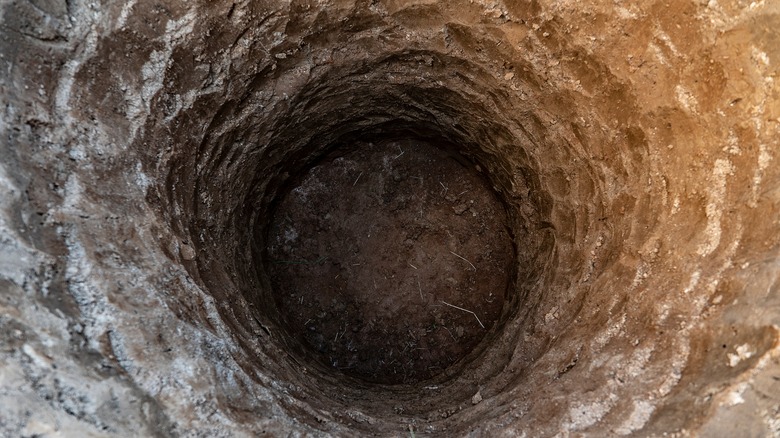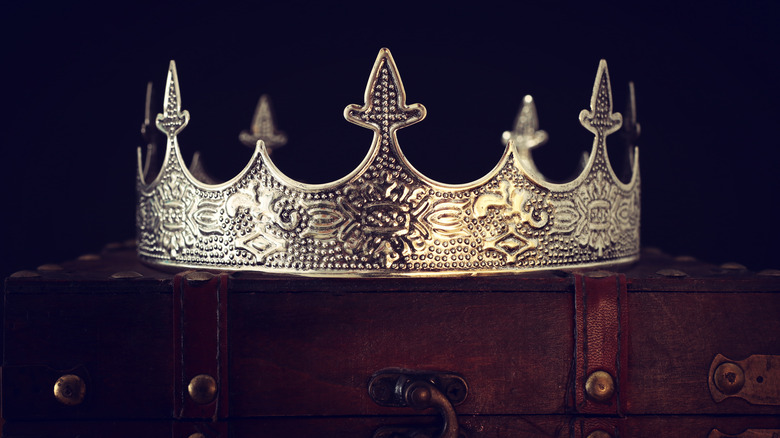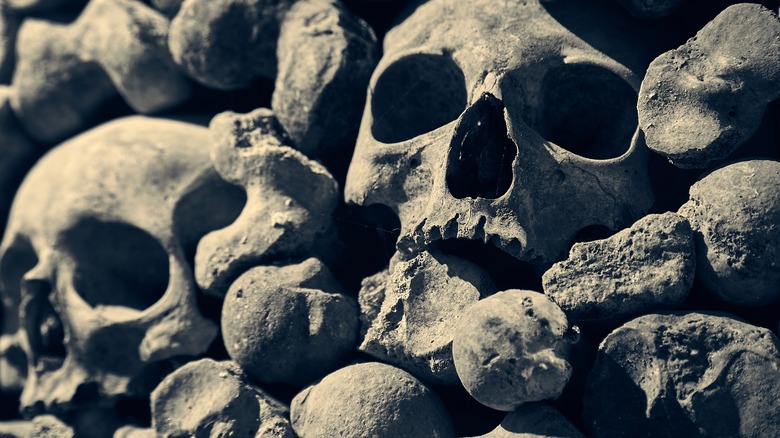What We Know About The Bodies Found In A Medieval Well In England
At first glance, "bodies in a well" might sound like an intriguingly macabre topic. Did they find that creepy ghost girl from "The Ring"? Or the water-bloated zombie from Season 2 of "The Walking Dead?" Or perhaps your run-of-the-mill peasant corpse from a 1000-year-old English village? Well, get it out of your system now, because the truth is a whole lot more disturbing, a whole lot less amusing, and looks a whole lot more anti-Semitic.
Back in 2004, construction workers in Norwich, England discovered 17 bodies at the bottom of an 800-year-old well. Out of the 17, it turns out 11 of them were children. It took until 2022 for DNA analysis to reveal that these 17 individuals were of Ashkenazi Jewish origin, as CNN reports. Particular genetic markers indicated the presence of rare genetic conditions often associated with Jewish populations, such as Tay-Sachs disease, a hereditary disorder that inhibits the breakdown of fatty cells in the brain and is usually fatal during childhood, per the Mayo Clinic.
We don't know exactly how these individuals died, although because of the disordered, jumbled position of the corpses, it seems likely that they were pushed down the well after death. The Guardian calls the find evidence of a "bloody medieval pogrom," while the BBC more moderately describes the bodies as "victims of anti-Semitism." It's impossible to say for sure, but given additional evidence and the political climate of Europe at the likely time the bodies were disposed of — during the Crusades — violence does seem the likely cause of death.
The Norman Invasion, the Crusades, and anti-Semitism
Let's be clear: looking at human history, staying alive hasn't always been easy. At present, child mortality is at its lowest and life expectancy is among its highest (via The World Bank), and they've even got loads of tofu options at Trader Joe's. In the past, however — say, roundabout 800 years ago when this well in Norwich, England was in use — things were particularly difficult. If you were Jewish, they were even harder.
The Jewish kingdom of Judea had come under Roman control all the way back in the 1st century CE. From then until the Roman Empire fell in 476, and after, Jews began spreading out from the Holy Land. Ashkenazi Jews are those of a particular lineage that made their way to Eastern Europe in the 9th century through modern-day Turkey by the 7th century, as The Conversation explains. Come 1066, Normandy's William the Conqueror took the English crown, and some of the Jews in his kingdom went over to England, as CNN says. Not everyone welcomed Jews to the neighborhood, though.
About 30 years later in 1095, Pope Urban II called for the First Crusade to retake Jerusalem, which had fallen to Seljuk Turks in 1071 (via History). Unfortunately, lots of Christians got a bit overzealous and took out their teeming rage on the closest non-Christians possible. Jewish communities in places like Speyer, Worms, and Mainz in Germany were razed, and Jews were thrown out onto the streets (via My Jewish Learning).
The Great Revolt and violence in England
At the same time as the Crusades raged, which lasted all the way to 1291 (via History), there was domestic trouble back in England. From 1135 all the way to the War of the Roses from 1455 to 1487, England experienced no less than six civil wars. Some were short, some were long, and some were more serious than others. And at the end of one such bloody conflict, it looks like some folks in Norwich, England might have — in a frustratingly repetitious historical turn — directed their aggression towards the Jews in their community.
In 1173, the sons of King Henry II, who ruled from 1154 to 1189 and came to power following a war of succession, decided they'd had enough of this whole "fleeting peace" thing and revolted against their father (via World History). Henry II had tried to quell their ambition by dolling out pieces of his kingdom to them, including Normandy, Britany, Ireland, Aquitaine, and more, but to no avail. The Great Revolt, as it was called, lasted from 1173 to 1174. As War History Online explains, it was ultimately unsuccessful, brutally put down, and resulted in nothing but a useless and tragic loss of life. When Henry II died, his son Richard I "the Lionhearted" took over, right at the onset of the Third Crusade.
This is the precise window of time that radiocarbon dating shows the Jews in the well at Norwich died, from 1161 to 1216.
The Third Crusade and murder in Norwich
We might be able to pinpoint the exact, documented event that describes the murder of the Ashkenazi Jews in Norwich whose bodies we've found. Almost directly after Richard the Lionhearted became king of England, he, along with Frederick I of Germany and Philip II of France, launched the Third Crusade (via the World History Encyclopedia). The Second Crusade had been a disaster, and folks were itching for a sequel, particularly those in an England of unrelenting civil unrest.
As CNN quotes, historian Ralph de Diceto wrote in his medieval manuscript "Imagines Historiarum II," "Many of those who were hastening to Jerusalem determined first to rise against the Jews before they invaded the Saracens. Accordingly on 6th February [in 1190 AD] all the Jews who were found in their own houses at Norwich were butchered; some had taken refuge in the castle." In other words, folks in Norwich killed the Jews in their town before those Jews could join the Third Crusade. And yes, the Jews living in Norwich at the time were Ashkenazi.
We can't say for sure that this is what happened, but it is a definite possibility. Four of those murdered — children — were related. Three of them were sisters, and the youngest was aged 5 to 10. This makes sense if families were huddled together, hiding from a mob before being dragged to their deaths.



